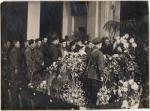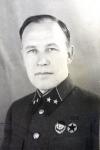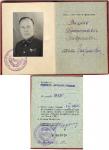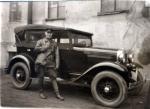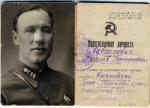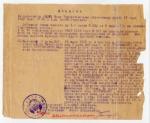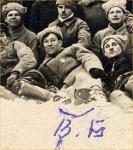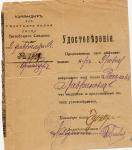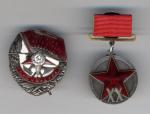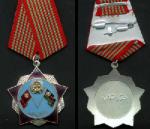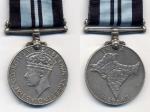-
Posts
14,343 -
Joined
-
Last visited
-
Days Won
28
Content Type
Profiles
Forums
Blogs
Gallery
Events
Store
Everything posted by Ed_Haynes
-
I guess this belongs in this thread? The medals are not so unusual, these days. They came in their original envelopes, with ribbon bars. Also not very unusual. 1- Independence and Freedom Merit Medal / Du Li Zhi Yu Jiang Zhang - 029010 2- Liberation Merit Medal / Jie Fang Jiang Zhang - 39260
-

Soviet A very simple group
Ed_Haynes replied to Ed_Haynes's topic in USSR: Soviet Orders, Medals & Decorations
Research continues in the 4 inches of documents and in Moscow. Watch this space. -

Soviet A very simple group
Ed_Haynes replied to Ed_Haynes's topic in USSR: Soviet Orders, Medals & Decorations
He was awarded a posthumous Order of the Red Banner by decree of the Presidium on 6 February 1942. -

Soviet A very simple group
Ed_Haynes replied to Ed_Haynes's topic in USSR: Soviet Orders, Medals & Decorations
-

Soviet A very simple group
Ed_Haynes replied to Ed_Haynes's topic in USSR: Soviet Orders, Medals & Decorations
Based on the doctor's report, also included, he suiffered "a contusion over the right brow arc with broken bone and five torn entrance wounds to the right temple". In other words, a serious head wound. RIP. -

Soviet A very simple group
Ed_Haynes replied to Ed_Haynes's topic in USSR: Soviet Orders, Medals & Decorations
But things take a down-turn when the war begins. "Peoples Commissariat "of the Defense of the Union SSR "HEADQUARTERS OF 23 ARMY "Department ___ "Subdivision ABTV [Automibile and Armored Troops] "22 September 1941 "#229/41 "CERTIFICATE "This is to certify that Major General V. B. LAVRINOVICH indeed fell the death of a hero in a fight for BELOOSTROV. "This certificate is issued to reveice permission for burial. "Chief of Starr, 23rd Army Military Commisar of the Headquarters "Major General 23rd Army, Sr. Battalion Comissar "/Ivanov/ /Romanov/" -

Soviet A very simple group
Ed_Haynes replied to Ed_Haynes's topic in USSR: Soviet Orders, Medals & Decorations
-

Soviet A very simple group
Ed_Haynes replied to Ed_Haynes's topic in USSR: Soviet Orders, Medals & Decorations
He onviously survived the purges. Only in 1941 did he finally get an award booklet for his Red Banner. (He seems to have had MAJOR problems in assembling/reassembling documentation, perhaps one reason this trove survives?) -

Soviet A very simple group
Ed_Haynes replied to Ed_Haynes's topic in USSR: Soviet Orders, Medals & Decorations
-

Soviet A very simple group
Ed_Haynes replied to Ed_Haynes's topic in USSR: Soviet Orders, Medals & Decorations
-

Soviet A very simple group
Ed_Haynes replied to Ed_Haynes's topic in USSR: Soviet Orders, Medals & Decorations
-

Soviet A very simple group
Ed_Haynes replied to Ed_Haynes's topic in USSR: Soviet Orders, Medals & Decorations
He continued into the post-Civil War Red Army, performing both political tasks and becoming one of the first armored corps officers. But old patterns died hard. -

Soviet A very simple group
Ed_Haynes replied to Ed_Haynes's topic in USSR: Soviet Orders, Medals & Decorations
But, note, he is wearing a medal! "EXCERPT "From Decree for 209/8th Turkistan Rifle Regiment of 15 July 1920, $29 Paragraph 1, regarding the combat personnel. "I announce the copy of the Decree for the 1st Army, #210, of 6 July of this year for the administrative department. "Paragraph 1. Based on the RVSR [Revolutionary Military Council of the Republic] Decree on 1919, #511 concerning the decree #2322 of the same year, the following servicemen are awarded the Order of the Red Banner for their combat feats: "2. Commander of 9th Platoon, 209th Vitebsk Rifle Regiment, LAVRINOVICH Vatslav Bronislavovich. "On 15 June 1919 during the fight near Uzbekovo comrade Lavrinovich commanded 9th Platoon of 209th regiment. He skillfully led his platoon on the right flank of the battalion combat order, inspired his men by personal example of courage, and managed to withstand and repel an enemy attack. After intensive artillery preparations using heavy and light artillery the enemy launched a second attack. [Lavrinovich] without regard to his life stood firm as a true warrior, put himself in the most dangerous spots, and held the position. The enemy desperately attacked for the third time in his sector and got as close as 40 paces from his position. At that point Comrade Lavrinovich shouted 'Hurray' and jumped out at the enemy, leading his company and the entire battalion. With a lightning and powerful bayonet charge he broke the enemy resistance and turned it into a panicky flight. During the pursuit Comrade Lavrinovich was all the time at the head of the infantry line. When the enemy made an attempt to stand near the villages of Bol'shoye Utyashevo and Zelim-Karamovo, he was on both occasions the first to throw himself before the enemy and continued to lead the pursuit of the destroyed enemy troops. "Commander of the 1st Army Zinov'ev. ?Member of the Revolutionary Military Council Paskutsky. "Chief of Staff Shefolovich. "True copy: clerk [signed]" -

Soviet A very simple group
Ed_Haynes replied to Ed_Haynes's topic in USSR: Soviet Orders, Medals & Decorations
-

Soviet A very simple group
Ed_Haynes replied to Ed_Haynes's topic in USSR: Soviet Orders, Medals & Decorations
-

Soviet A very simple group
Ed_Haynes replied to Ed_Haynes's topic in USSR: Soviet Orders, Medals & Decorations
Camer with a metric ton of documentation, and research in Moscow has been done but more is coming (and the patience of my colleague who does Russian history to do translations is limited). Here are the bare bones of the story, high points only. Certificate that he is commander of 9th Company, 1st Rifle Regiment named for Vitebk-Soudep, executed Orenburg (Siberia), 2 February 1919: -
A very simple pair. Major General Vatslav Bronislavovich Lavrinovich, 291st Rifle Division, 23rd Army 1- Order of the Red Banner, type 1 - 10825 (numbered on both badge and screw-plate, though repaired) 2- Jubilee Medal for 20 Years of the Workers' and Peasants' Red Army - 15126 - no document for this one
-
Khan Bahadur Nasarvanji Navraoji Sadri, Inspector-General of Police, Kolhapur State Very much mounted-as-worn, idiosyncratically and with a pre-WWI "feel". 1- Khan Bahadur, George VI -- "Khan Sahib Nasarvanji Navraoji, Sadri 11th July 1940" -- Not. No. 84-H of 11 July 1940, "Khan Sahib Nasarvanji Navraoji, Sadri, Assistant to the Deputy Inspector General of Police, Criminal Investigation Department, Poona, Bombay" PSV 42-H/1940: ?(Pay = Rs.850/- p.m.) ?This officer joined the Police force in 1907 as a Sub-Inspector of Police, and by his meritorious work and record was promoted to the rank of Deputy Superintendent in 1929 and is now officiating as District Superintendent of Police, which appointment he is likely to hold until retirement. His record has been one of conspicuous ability and loyalty, as evidenced by the fact that he was awarded the title of Khan Sahib for his services in restoring order in Sholapur after the debacle there. In 1936 he was awarded the Indian Police Medal in recognition of his further meritorious work as a Police officer. In 1937 he was selected as the Deputy Superintendent of the Police Contingent from the Province sent to England for the Coronation of His Majesty the King-Emperor, and rfeceived very favourable commendations from the officers in charge for his own exemplary behaviour and for his general work in looking after the members of the Contingent. ?He is due to retire in March 1941, and is recommended for promotion to Khan Bahadur towards the end of a distinguished and loyal career under the Crown. He was previously recommended for this promotion in connection with the New Year?s Day (1940) Honours List.? 2- Durbar 1911 - "NOSSERWAN NOVROJI SADRI" 3- Jubilee 1935 - "KHAN SAHEB NUSSERWAN N. SADRI" -- On the roll as "Khan Sahib Nasarwanji Navraji Sadri, Deputy Superintendent of Police, Sholapur" 4- Coronation 1936 -- "KHAN SAHEB N. N. SADRI" 5- King's Police and Fire Services Medal for Distinguished Services, George VI, 1st variety -- "K. B. NUSSERWANJI NOWROSJI SADRI, I. G. OF POLICE, KOLHAPUR STATE." -- Gazette of India, 14 June 1945 6- Indian Police Medal, George V, 2nd variety -- "N. Navraoji Sadri, Dy. Supdt, Bombay Police" 7- Kolhapur: Coronation Medal of Chhatrapati Shahji II, 1947 -- This is the first specimen of this medal seen mounted/ ribboned, so it is important for establishing the correct ribbon. 8- Khan Sahib, George V, 2nd variety -- "Nasarwanji Navroji Sadri 1st Jany 1931" -- Not. No 24-H of 1 January 1931 "Nasarwanji Navroji Sadri, Temporary Deputy Superintendent of Police, Greater Indian Peninsula and Madras and Southern Mahratta Railways, Poona" F&P, 54(2)-H/1930: ?This officer has an excellent record of 22 years? service as a Sub-Inspector. He was specially selected as Inspector in charge of the special force at Malegaon after the serious rioting there in 1921 when he acquitted himself admirably. During 1928 he was Inspector in charge of Bardoli and worked with the greatest devotion during the Satyagraha campaign in that taluka. Despite the general opposition encountered on all sides in the taluka, he set an example of loyalty to all and performed the many difficult tasks entrusted to him with determination and resource. Before the year closed, Mr. Sadri was again called on to play a part in the serious riots which convulsed Surat City in September 1928. He spent several days and nights with little or no rest or food and throughout those tragic happenings, he worked with conspicupus courage and by his tact and untiring energy assisted considerably in restoring peace to the disturbed city. ?When the Railway strike of 1903 broke out he was employed as a Deputy Superintendent of Police on the G.I.P. Railway. He rendered the most valuable assistance to his Superintendent and never spared himself in the discharge of the many arduous duties arising out of the strike. He was recently selected for the important duty of escorting the Nehrus and Dr. Mahmed from Poona to Naini and he discharged his duty most efficiently. ?[bombay has reported that the Baroda Darbar to which this gentleman belongs has no objection to this award.]? 9- Masonic Medal, "Lodge Royal Jubilee No 742 S.C." -- named "TO WOR. BRO. KHAN SAHEB N. N. SADRY SECRETARY 1932-33" I am convinced he is one of those numerous ego-boosting biography volumes of the period, but so far he is elusive. Much research looms. The group also has his ribbon bars. (Hope you can see it, given small image sizes available.)
-

Soviet Red Banner of Labour
Ed_Haynes replied to Chris S's topic in USSR: Soviet Orders, Medals & Decorations
-
-
Hi David, here I am. Will add some images and some information. (Shameless capitalism: The book is with the publisher. Sounds of anxious waiting!) Your unknown ribbon, by the way, is the OP Vijar Star (first ribbon); it has now been changed to add a blue stripe for the navy. What you call "Rakash" is the OP Vijay Medal. These miniature clasps are an unfortunbate recent addition, though the Chief is being urged -- even as I write -- to reverse this dumb decision. Ed Haynes
-
These are not ribbon bars, they are the medal bars made up when medals are not there of, oftem, old medal bars where the medals have been stripped for remounting that are re-stitched and sold to western collectors by some military tailors at least in Delhi. If you want, I can post examples and choke you with them. Ed Haynes
-

THE INDIA SERVICE MEDAL 1939-1945
Ed_Haynes replied to a topic in Great Britain: Orders, Gallantry, Campaign Medals
This was, in many ways, the Indian equivalent of the Defence Medal (and, in fact, much of the correspondence regarding it made reference to it as the "Indian Defence Medal"). The way the Defence Medal qualifications had written, they were, intentionally, very "Blitz-specific" and it was almost impossible for non-European personnel of the Indian Army to qualify for it (Iran/Iraq/Mediterranean was the main route). Auckinleck, in particular, attached this as being essentially racist and led the charge for the ISM. Ed Haynes




